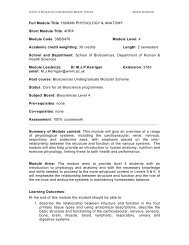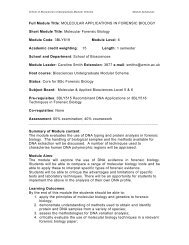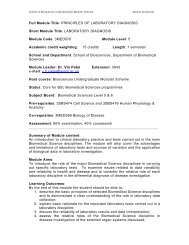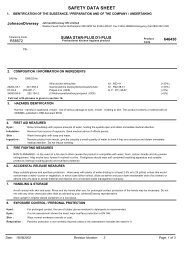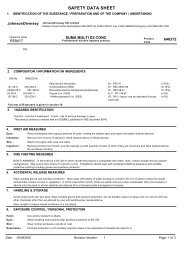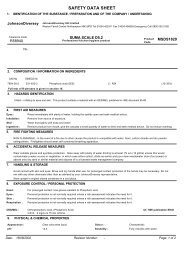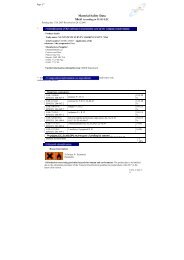CONTENTS 1. Introduction 1.1 Course Outline 1 1.2 Introduction ...
CONTENTS 1. Introduction 1.1 Course Outline 1 1.2 Introduction ...
CONTENTS 1. Introduction 1.1 Course Outline 1 1.2 Introduction ...
You also want an ePaper? Increase the reach of your titles
YUMPU automatically turns print PDFs into web optimized ePapers that Google loves.
Full Module Title:<br />
METHODS IN PHOTOSCIENCE<br />
Short Module Title: PHOTOSCIENCE METHODS<br />
Module Code: 2DPI411 Module Level: 4<br />
Academic credit weighting: 30 credits. Length: 1 semester<br />
School:<br />
Media, Art and Design.<br />
Department:<br />
Photographic and Digital Media<br />
Module Leader: Efie Bilissi Extension: 4581<br />
Host <strong>Course</strong>:<br />
BSc(Hons) Photography and Digital Imaging<br />
Status:<br />
Core.<br />
Subject Board:<br />
Pre-requisites:<br />
None.<br />
Co-requisites:<br />
None.<br />
Assessment:<br />
40% laboratory work, 20% written coursework, 40% examination.<br />
Summary of Module content:<br />
Methods of Geometrical Optics. Characteristic (input-output) curves of imaging systems.<br />
The basis of colour. <strong>Introduction</strong> to performance assessment (Resolution, sharpness, noise, MTF).<br />
Applicable Mathematics and statistics.<br />
Module Aims:<br />
• To introduce the analytical skills that underpin the scientific study of images and imaging<br />
systems.<br />
• To supply transferable mathematical skills.<br />
• To introduce the fundamental limitations of images and imaging systems as carriers of<br />
information.<br />
• To introduce concepts of image quality and their measurement.<br />
• To implement simple theoretical performance measures into practical schemes for a range of<br />
systems and images.<br />
• To develop the practical skills necessary for the reliable collection of data for image quality<br />
measurement.<br />
• To analyse and present results and conclusions from an investigation, with due regard of<br />
experimental error, procedural assumptions and other necessary practical simplifications.<br />
Learning Outcomes:<br />
On completion of the module the successful student will be able to:<br />
<strong>1.</strong> Define some simple measures of image quality and imaging system performance and explain<br />
their importance.<br />
2. Measure and interpret the input-output relationships for a variety of imaging processes.<br />
3. Explain the significance of linear and non-linear systems in imaging chains.<br />
4. Relate aspects of image quality to measurable properties and measure simple aspects of<br />
objective image quality.<br />
5. Describe the basic relationships between image properties and the physical processes<br />
producing the image.<br />
6. Employ the basic methods of geometrical constructs and ray tracing in studying image<br />
formation in optical systems.<br />
7. Understand the basic principles of calculus as a powerful analytical tool.<br />
8. Use some important ideas and results from probability theory and statistics.<br />
9. Work in a group and plan simple projects.<br />
Indicative syllabus content:<br />
Optics: Light rays. Geometrical optics. Cardinal points, stops and pupils.<br />
Measurement units: Illumination, exposure, intensity, transmittance, density, voltage, pixel level.<br />
Macroscopic input-output relationships: Photographic D-log H, Digital: dv-exposure.<br />
Sensitivity: Film speed, Responsivity.<br />
Tone reproduction: Quadrant diagrams for photographic and digital systems.<br />
DPI_Hbook 49 ©University of Westminster





